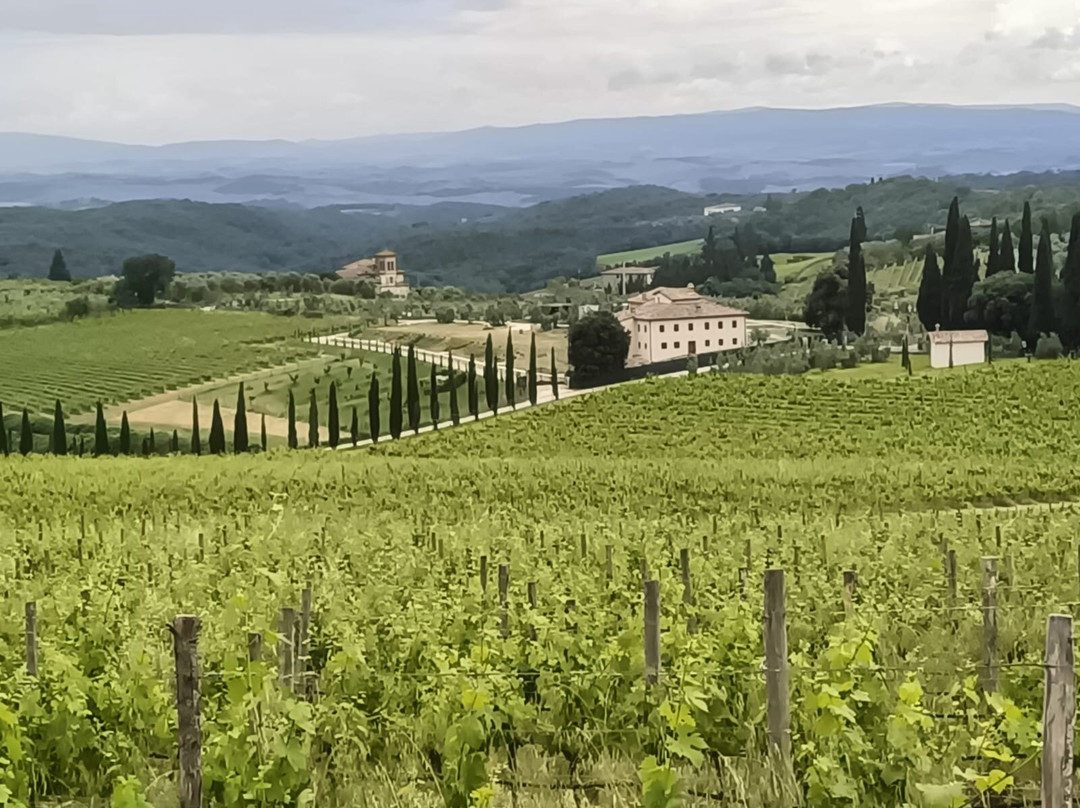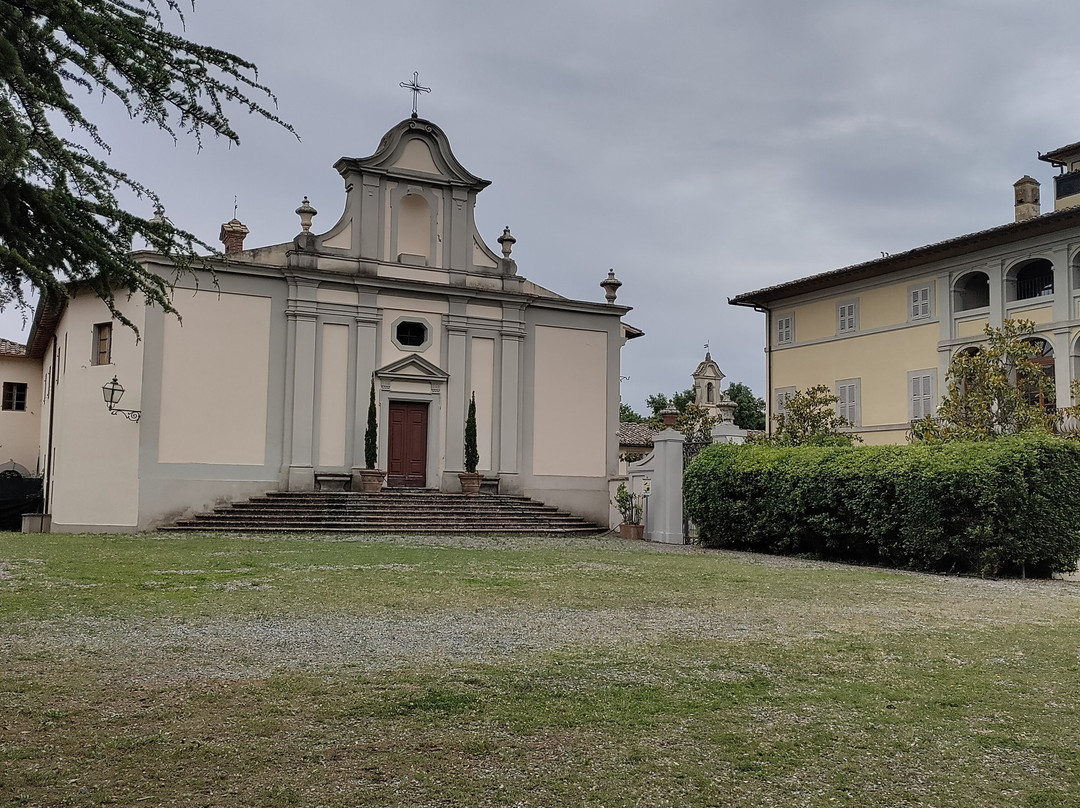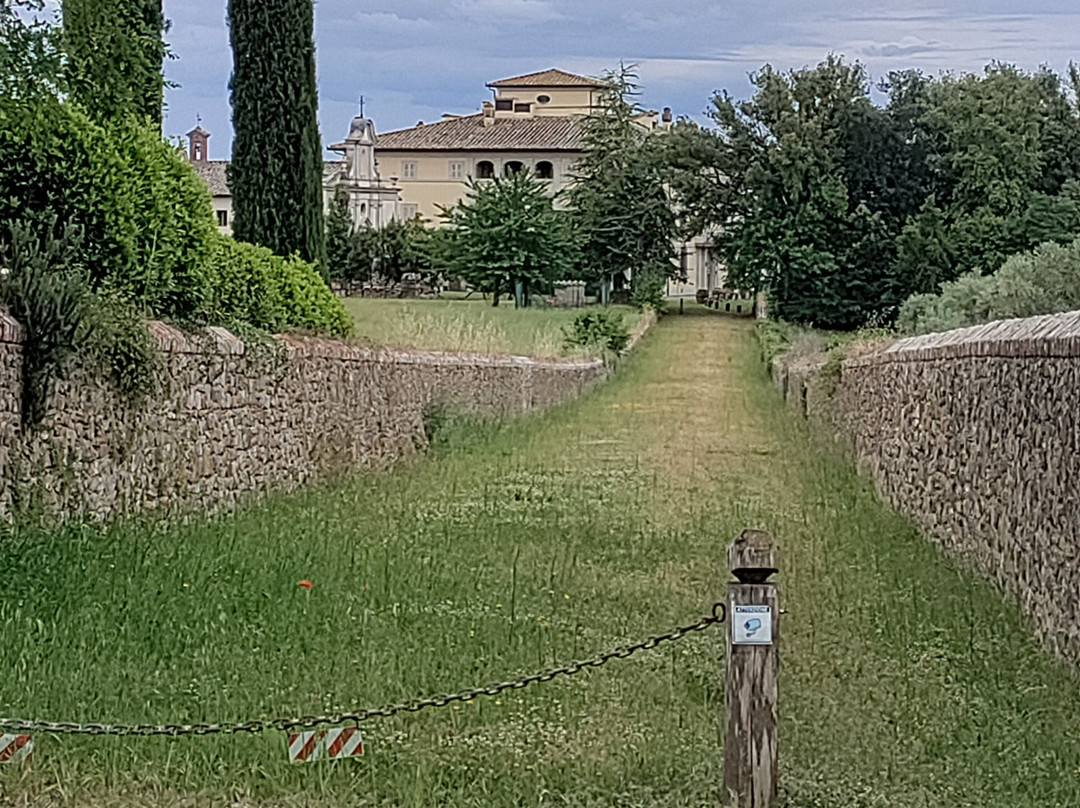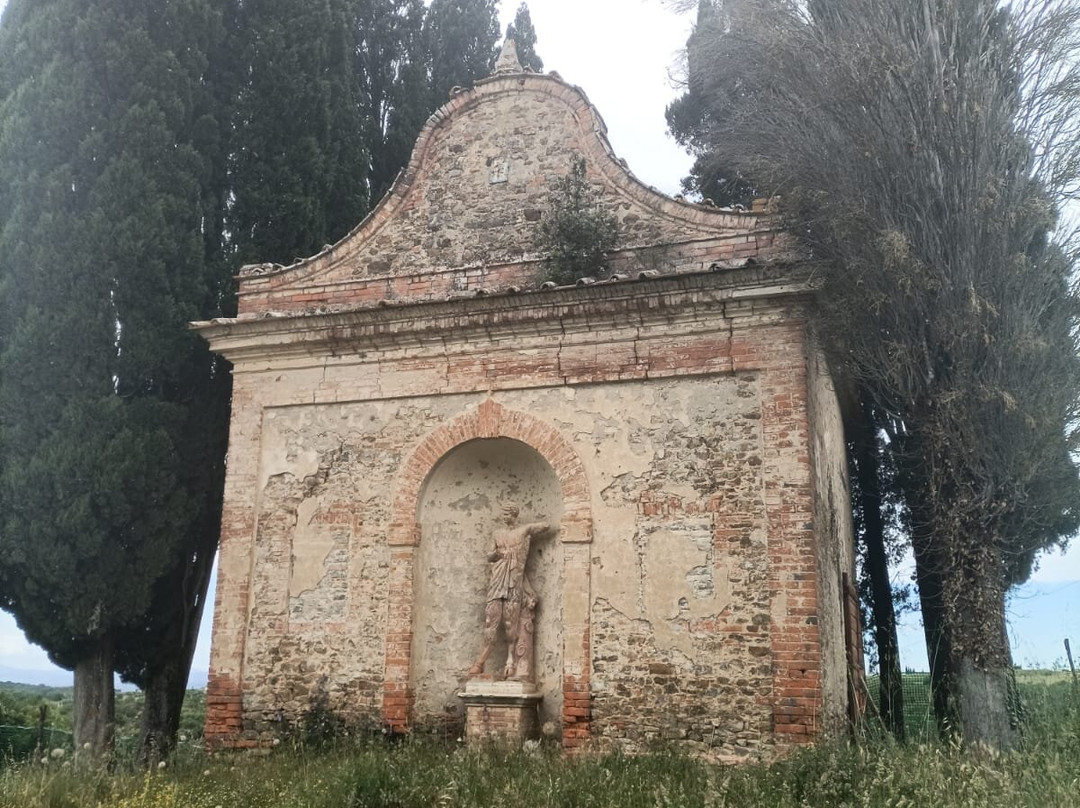的点评
For a better awareness of this enchanting village, do a circular hike downstream from it.
Borgo di San Gusme的点评
点评:My comment regarding the village of San Gusmè would risk appearing repetitive. So I choose to describe the circular hiking that I did downstream from it, and which gives a more complete (and therefore more pleasant) awareness of this village.
The ring isn't marked on the ground, but can be followed on the “Komoot” app. It is approximately 6 km long, with a height difference of ca. 140 m. So it's easy and accessible to everyone.
If you follow the ring in an anti-clockwise direction, you will encounter, more or less halfway along the route, the entity which - although not so evident today - for centuries has influenced the existence of San Gusmé, namely the center of the "Villa d' Arceno" estate.
The "villa" of the estate today is used as a charming accommodation facility, but until the mid-20th century the whole estate was a large agricultural company. Large for hilly Italy, because of around 1000 hectares (size anyway not rare in this part of the Tuscany). The estate was organized into "poderi" (land units) with a house for peasants located more or less in the center of each "podere"; each podere was cultivated, on behalf of the owner, by a family of "mezzadri" (sharecroppers peasants). At the top of the company and in the center of the estate there was the "fattoria" (farm) managed by a "fattore" (director), to which a "villa" was attached, i.e. the residence for the owners' leisure time.
This large estate was formed, with a process that began in the Middle Ages and was completed in the early modern age, by purchasing other estates and rural homes from small owners, peasants or other subjects. In this way it has practically incorporated, in addition to other inhabited centers, the entire territory in the vicinity of San Gusmé; which therefore became functioning almost as a "service" village for the company. And this has probably contributed to the good preservation of the village itself to date.
The circular route allows you to touch, among other things, the former "fattoria", the villa (transformed today into a resort), built in its current form in 1671; and to appreciate the extension of the company's territory, and the grandeur of other achievements; like the "landscape garden" surrounded by a high wall, also immense (and unfortunately currently closed to visits) accomplished in 1825 by the famous Sienese landscape architect Agostino Fantastici.
In short, we highly recommend this circuit to those who aren't satisfied with the usual category of the "enchanting village" and who want to grasp the real dynamics of this area both yesterday and today.
The ring isn't marked on the ground, but can be followed on the “Komoot” app. It is approximately 6 km long, with a height difference of ca. 140 m. So it's easy and accessible to everyone.
If you follow the ring in an anti-clockwise direction, you will encounter, more or less halfway along the route, the entity which - although not so evident today - for centuries has influenced the existence of San Gusmé, namely the center of the "Villa d' Arceno" estate.
The "villa" of the estate today is used as a charming accommodation facility, but until the mid-20th century the whole estate was a large agricultural company. Large for hilly Italy, because of around 1000 hectares (size anyway not rare in this part of the Tuscany). The estate was organized into "poderi" (land units) with a house for peasants located more or less in the center of each "podere"; each podere was cultivated, on behalf of the owner, by a family of "mezzadri" (sharecroppers peasants). At the top of the company and in the center of the estate there was the "fattoria" (farm) managed by a "fattore" (director), to which a "villa" was attached, i.e. the residence for the owners' leisure time.
This large estate was formed, with a process that began in the Middle Ages and was completed in the early modern age, by purchasing other estates and rural homes from small owners, peasants or other subjects. In this way it has practically incorporated, in addition to other inhabited centers, the entire territory in the vicinity of San Gusmé; which therefore became functioning almost as a "service" village for the company. And this has probably contributed to the good preservation of the village itself to date.
The circular route allows you to touch, among other things, the former "fattoria", the villa (transformed today into a resort), built in its current form in 1671; and to appreciate the extension of the company's territory, and the grandeur of other achievements; like the "landscape garden" surrounded by a high wall, also immense (and unfortunately currently closed to visits) accomplished in 1825 by the famous Sienese landscape architect Agostino Fantastici.
In short, we highly recommend this circuit to those who aren't satisfied with the usual category of the "enchanting village" and who want to grasp the real dynamics of this area both yesterday and today.
翻译:我对 San Gusmè 村的评论可能会显得重复。所以我选择描述我沿着它下游进行的环形徒步旅行,这可以更全面(因此也更愉快)地了解这个村庄。
环形路线没有在地面上标记,但可以在“Komoot”应用程序上跟踪。它长约 6 公里,高差约 140 米。所以每个人都可以轻松到达。
如果您沿逆时针方向沿着环形路线行走,您会在路线的大约一半处遇到一个实体,尽管今天并不那么明显,但几个世纪以来一直影响着 San Gusmé 的存在,即“Villa d' Arceno”庄园的中心。
庄园的“别墅”今天被用作迷人的住宿设施,但直到 20 世纪中叶,整个庄园还是一家大型农业公司。对于意大利的丘陵地区来说,这是一个很大的规模,因为大约有 1000 公顷(无论如何,在托斯卡纳的这部分地区,这个规模并不罕见)。庄园被划分为“poderi”(土地单位),每个“podere”的中央或多或少都有一栋农民住宅;每个podere由“mezzadri”(佃农)家庭代表所有者耕种。在公司的顶层和庄园的中心,有一个由“fattore”(主管)管理的“fattoria”(农场),旁边有一座“别墅”,即所有者休闲时的住所。
这个大庄园的形成过程始于中世纪,在近代早期完成,通过从小业主、农民或其他臣民手中购买其他庄园和农村住宅。通过这种方式,它实际上除了其他居住中心外,还涵盖了圣古斯梅附近的整个领土;因此,它几乎成为了公司的“服务”村。这可能有助于村庄本身至今的良好保存。
这条环线让您可以接触到以前的“农场”、别墅(如今已改造成度假村),这些别墅建于 1671 年,如今的样子;您可以欣赏公司领土的扩张,以及其他宏伟的成就;例如被高墙环绕的“景观花园”,同样巨大(遗憾的是目前不对游客开放),由著名的锡耶纳景观设计师 Agostino Fantastici 于 1825 年完成。
总之,对于那些不满足于通常的“迷人村庄”类别,并希望了解该地区过去和现在的真实动态的人,我们强烈推荐这条线路。
环形路线没有在地面上标记,但可以在“Komoot”应用程序上跟踪。它长约 6 公里,高差约 140 米。所以每个人都可以轻松到达。
如果您沿逆时针方向沿着环形路线行走,您会在路线的大约一半处遇到一个实体,尽管今天并不那么明显,但几个世纪以来一直影响着 San Gusmé 的存在,即“Villa d' Arceno”庄园的中心。
庄园的“别墅”今天被用作迷人的住宿设施,但直到 20 世纪中叶,整个庄园还是一家大型农业公司。对于意大利的丘陵地区来说,这是一个很大的规模,因为大约有 1000 公顷(无论如何,在托斯卡纳的这部分地区,这个规模并不罕见)。庄园被划分为“poderi”(土地单位),每个“podere”的中央或多或少都有一栋农民住宅;每个podere由“mezzadri”(佃农)家庭代表所有者耕种。在公司的顶层和庄园的中心,有一个由“fattore”(主管)管理的“fattoria”(农场),旁边有一座“别墅”,即所有者休闲时的住所。
这个大庄园的形成过程始于中世纪,在近代早期完成,通过从小业主、农民或其他臣民手中购买其他庄园和农村住宅。通过这种方式,它实际上除了其他居住中心外,还涵盖了圣古斯梅附近的整个领土;因此,它几乎成为了公司的“服务”村。这可能有助于村庄本身至今的良好保存。
这条环线让您可以接触到以前的“农场”、别墅(如今已改造成度假村),这些别墅建于 1671 年,如今的样子;您可以欣赏公司领土的扩张,以及其他宏伟的成就;例如被高墙环绕的“景观花园”,同样巨大(遗憾的是目前不对游客开放),由著名的锡耶纳景观设计师 Agostino Fantastici 于 1825 年完成。
总之,对于那些不满足于通常的“迷人村庄”类别,并希望了解该地区过去和现在的真实动态的人,我们强烈推荐这条线路。





此点评仅代表旅行者个人的主观意见,并不代表TripAdvisor以及其合作方的意见。
关于我们
|
新闻动态
|
商务合作
|
会员中心
|
业主中心
|
业主通
|
常见问题
|
意见反馈
|
联系我们
|
营业执照
© 2025 Tripadvisor 版权所有。
使用条款 |隐私政策 |网站工作原理
部分照片由 VFM Leonardo 提供。
* Tripadvisor不是旅行社,也不是旅游预订服务代理商。我们提供免费、客观、公正的旅游资讯服务。 (显示更多)
TripAdvisor LLC 既不是预订代理商,也不是旅游运营商,不会向网站用户收取任何服务费。 按照规定,在 Tripadvisor 发布机票价格、游览和旅行套餐的合作伙伴(航空公司、旅行提供商及预订代理商),其标价须包含所有费用和附加费用。 例如, 机场出入境税费、消费税与其他服务费、手续费、杂费及附加费用。 当您向我们的某个合作伙伴进行预订时,请务必查阅他们的网站以了解当地行政部门要求的所有适用费用的具体情况。 除非另有说明,机票价格通常指的是一个人的价格(以人民币计)。
为方便起见,TripAdvisor LLC 根据从我们的预订合作伙伴获取的空房率计算每个酒店的均价。 对于游览和景点来说,所显示价格通常是每位成人的最低可用价格。 对于列出的任何旅行套餐或优惠,TripAdvisor LLC 无法保证任何特定的费率或价格。 此外,酒店均价每晚会更新,并以您的首选币种表示(使用现行汇率)。 由于这些已换算的价格是预估价格,因此,有关具体金额和币种请与预订网站进行核实。
此外,TripAdvisor LLC 无法保证我们网站上宣传的价格随时有效。 标价可能需要预订一定天数才能生效,或有不可用日期、使用条件或限制。
TripAdvisor公司对外部网站的内容一概不负责。优惠价格中不含税和其他费用。
ICP证:沪B2-20200433
沪ICP备20013175号
 沪公网安备31010502005427号
沪公网安备31010502005427号鹰程信息技术(上海)有限公司
货币/国家及地区
¥CNY
中国

